 |
| Wall of Constantinople |
The Byzantine Republic
(From the Sandusky Register) - Conventional historical thinking is that the Roman Empire "fell" in A.D. 476, when the Germanic tribes finished their occupation of western Europe by deposing the last Western Roman emperor.
But Byzantine and classical scholar Anthony Kaldellis, a professor in the Department of Classics of The Ohio State University, argues that not only did the eastern half of the empire survive for centuries, it kept its Roman identity, even though its citizens mostly spoke Greek.
His new book, "The Byzantine Republic: People and Power in New Rome" (Harvard University Press), defies the received wisdom in Byzantine studies by insisting that Byzantium, as the Eastern Roman Empire is usually known, was a Roman republic in which the people were sovereign. Although it had an emperor, he did not rule as the absolute monarch that he's usually depicted as, Kaldellis asserts. His startling book is aimed at scholars but is well written enough to interest general readers who enjoy history.
 |
| (Amazon.com) |
Kaldellis' official university website lists 18 different books that he wrote, translated or edited, and numerous articles, book chapters and reviews. His translations include major Byzantine historians such as Prokopios, the major source for figures such as Justinian I and Belisarius.
He's currently working on a narrative history of Byzantium from 955 to 1097 A.D., just before the beginning of the Crusades, and he has other projects in the works. He also shoulders a full load of classes, including classes in Latin, Greek, classical literature and classical history.
He's currently working on a narrative history of Byzantium from 955 to 1097 A.D., just before the beginning of the Crusades, and he has other projects in the works. He also shoulders a full load of classes, including classes in Latin, Greek, classical literature and classical history.
Despite all that, he took time to answer our questions about his new book and other issues:
Sandusky Register: Your new book, "The Byzantine Republic," argues that the Eastern Roman Empire was a republican state at least as much as it was a monarchy. How did the obvious effect that the people had on Byzantine governance (you assemble lots of evidence) escape the attention of historians for so long?
Kaldellis: Like economists, historians see what they are trained to see, and prioritize their attention based on the theories they have been taught. Suppose I tell you that you are about to enter a room that contains a powerful king, a queen, a general, and a bishop. You go in and, indeed, there they are, in all their finery, and make quite an impression. They are everything you expect. Then, when you come out, I ask you what you saw. You will say, a king, a queen, a general, and a bishop. You will most likely not mention the non-descript servant who entered now and then. But for all you know he was holding them hostage with a pistol. Gosford Park has a similar version of how this bias works.
 There are many reasons why the role of the people is systematically overlooked. Like political scientists, historians are trained to think of politics as something that takes places among elites. It’s all about factions, alliances, economic interests, and the like. Even when they study democratic Athens, the most radically egalitarian society that has ever existed (for men), they still look for elites. Yet notice how unprepared all the experts are when the people rise up even today and try to overthrow regimes, in Paris, Cairo, Athens, and Istanbul. The experts don’t understand what’s going on, they don’t have the vocabulary for it, they can’t analyze it. It’s not how they think politics works. When it comes to popular interventions specifically, historians and other social scientists are averse to seeing instability as systemic. They like to know the rules of the game, and hate the idea that what no one can foresee or control comes along and upends everything, like Taleb’s Black Swan.
There are many reasons why the role of the people is systematically overlooked. Like political scientists, historians are trained to think of politics as something that takes places among elites. It’s all about factions, alliances, economic interests, and the like. Even when they study democratic Athens, the most radically egalitarian society that has ever existed (for men), they still look for elites. Yet notice how unprepared all the experts are when the people rise up even today and try to overthrow regimes, in Paris, Cairo, Athens, and Istanbul. The experts don’t understand what’s going on, they don’t have the vocabulary for it, they can’t analyze it. It’s not how they think politics works. When it comes to popular interventions specifically, historians and other social scientists are averse to seeing instability as systemic. They like to know the rules of the game, and hate the idea that what no one can foresee or control comes along and upends everything, like Taleb’s Black Swan. Popular interventions were a regular but unpredictable fact of life in the Byzantine empire. Historians “see” them because they are all over the place in the evidence, but in every individual case they marginalize them, saying that it was only an isolated incident from which we can’t draw general conclusions. You often hear this kind of thing in the news today. Then suddenly there are a hundred thousand people in the streets screaming for blood.
Finally, Byzantine Studies is an extremely repetitive and conservative field. You read the same thing over and over again, that the emperor was there to do God’s work, and you don’t “see” that he was also there to do well by his people and that they could do something about it when he failed. Historians take all this imperial propaganda about “emperors protected by God” at face value as if that was how society worked. In reality, not a single emperor was protected by God. Go ask Mubakar.
 |
| The Hippodrome of Constantinople (Antoine Helbert.com) |
Sandusky Register: The ancient Greeks have enjoyed a good press for centuries for their contributions to the idea of liberty. (John Stuart Mill, the famous British libertarian philosopher, said the Battle of Marathon was an important "event in British history.") Why do the Byzantines get such bad press?
Kaldellis: First I should say that the Byzantines have been getting a much better press lately. Exhibitions of their art are great successes, and may even draw more visitors than exhibitions of classical or Renaissance art. Our courses in Byzantine history also draw large enrollments – in Ohio! But of course you’re right, historically Byzantium has not been served generously by opinion-makers in the west. There are reasons for this, but they will teach you more about how opinion is manufactured in the west than about Byzantium. Specifically, in the Enlightenment, a number of political theorists chose to use Byzantium as a negative model for absolutism and theocracy, for all the bad things that happen when Christianity takes over both culture and government. They couldn’t talk directly about their own nasty governments, often run by priests, so they talked about them indirectly as “Byzantium.” They did not know much about it, but they didn’t have to. It was a useful imaginary construct that promoted their enlightened projects. Then, once they had had their Revolutions and what not, the model ceased to be useful and they dropped the anti-Byzantine polemic, but the odium remained attached to the name.
There have been other reasons why the west has at times demonized Byzantium. During the Cold War, it was taken by some to be the matrix of the Soviet Union. While “free” ancient Greece explains the capitalist west, Byzantium explains everything wrong in the Russian Mind (i.e., servility, superstition, the outrageous idea that Christians should share with each other…). All complete nonsense, of course. Can we move on now? Let’s see.
 |
| Hagia Sophia |
Sandusky Register: Is there a good survey of Byzantine history that you can recommend to an interested amateur such as myself?
Kaldellis: There used to be such a book, but it is now hopelessly outdated. More recent efforts are closer to textbooks, or dry narratives, or way too long, or extremely condensed. One that is neither too long nor too condensed is my colleague Tim Gregory’s History of Byzantium. There are also books that try to present the civilization as a whole to beginners, and that is a good way to go about it for a state that lasted over 1100 years. Here I recommend Judith Herrin’s Byzantium: The Surprising Life of a Medieval Empire, though it plays it too safe for me at times, still too much about emperors, monks, and orthodoxy. Do you know that still today, in the year 2015, we have only a single book about the Byzantines’ interest in erotic matters, and that was written thirty years ago in German? The material is all there, but Byzantinists don’t “see” it, even when it’s right there, and they are too addicted to the model of the “Orthodox society” to make sense of it. The Byzantines were not as prudish as modern Byzantinists are, and hardly as respectful of imperial authority or the Church. The field is suffocating in its own incense.
If I may deviate from your question, I would recommend that you bypass modern historians and go straight to the sources: start with translations of the historians Ammianus Marcellinus (fourth century), Prokopios (sixth), Psellos and Attaleiates (eleventh), and Choniates (twelfth-thirteenth). That is how I started my study of Byzantium: I read the sequence of the historians in Greek from beginning to end. Man, was that a good investment of my time! And it kept me out of trouble during my twenties.
Sandusky Register: A bestselling book, "How the Irish Saved Civilization," argued back in 1995 that Irish monks deserve credit for preserving classical literature. Shouldn't the Byzantines get more credit than the Irish?
Kaldellis: Other than that book, which made a lot of money by catering to a specific demographic in the U.S., I am not aware of anyone else believing or promoting such amusing claims. I mean, a lot of people played a part, whether large or small, in the huge story that was the preservation of classical culture. It is an ongoing story, and it remains to be seen whether our own civilization will do as well as the Byzantines or the Arabs did. They were the two peoples who played the major roles during the Middle Ages, the Byzantines mostly for the poetry, history writing, and rhetoric, the Arabs for the philosophy and science, including medicine.
Actually, the Byzantines get recognition for this service, but it is often grudging. Down to about 1900, historians had an incentive to present Byzantine culture as radically unclassical. This was because the western powers were in the business of stealing classical art, manuscripts, and monuments from the former-Byzantine lands and they had to invent rationalizations for doing so, such as “they never liked this stuff anyway,” “they don’t appreciate what they’ve got,” “they believe statues are full of demons.” So you, a modern European, can take it from them, because you are its “true” heir, and you put in a museum or a library. But you acknowledge that they kept it through all those centuries, even if you believe that it was “meaningless” to them. These attitudes are still very much around, by the way. In this view, Byzantium was not part of Europe. Recently, however, there have been moves to include Byzantium in a generalized European preservation of classical literature, but I am skeptical. The goal seems to be to deny that Europe needed the Arabic contributions – which were in fact crucial – because they had the Byzantine ones. Byzantinists should resist this poisoned gift. So now they want to include us… but not because they like us; they just need us to fight Islam. Thanks, but no thanks.
 |
| Equestrian Statue of Justinian |
Sandusky Register: You have written, and other historians have written, that the Greek speakers in the Byzantine Empire referred to themselves as "Romans." Did they do that right up until 1453? And if so, when did they finally stop?
Kaldellis: The short answers are, Yes, and, Around 1900 AD. Of course, technically there weren’t any Byzantines after 1453. Being Roman in Byzantium – just as in ancient Rome – meant being part of the Roman polity: sharing its customs, obeying its laws, serving in its armies, taking part in its politics, and worshipping its gods (or God). But there was no Roman polity in Constantinople after 1453, only a multi-lingual Orthodox population which the Ottoman sultans grouped together, for their own purposes, as the Rum (Romans). The Greek-speaking portion of that group continued to call itself Roman well into the nineteenth century, and in some places into the twentieth. After the Greek Revolution in 1821, it had to be reeducated into accepting a Greek national identity. For a while the two labels and identities coexisted, then finally the Greek one won out.
The real question is, will western scholars ever accept the Byzantines as true Romans? Not merely to say that “they called themselves Romans” – a strange way of putting it that we use for no other people in history – but to actually accept them as such. I am not saying that we abandon the term “Byzantium,” but that we understand better what it refers to. This will require some serious rethinking about who “owns” the Roman tradition. I put it to you that just as strong a case can be made for the Greek-speaking Byzantines as for the Latin-speaking Catholics of the Middle Ages. Are we ready for a Roman Byzantium? To finally accept the Byzantines for who they (said they) were?
 |
| Emperor Constantine I presents a representation of the city of Constantinople as tribute to an enthroned Mary and Christ Child in this church mosaic. St Sophia, c. 1000 |
 |
| Roman Emperor Constantine IV (652 to 685) and his court. Constantine's reign saw the first serious check to nearly 50 years of uninterrupted Islamic expansion. |
(Sandusky Register.com) (www.antoine-helbert.com/fr)
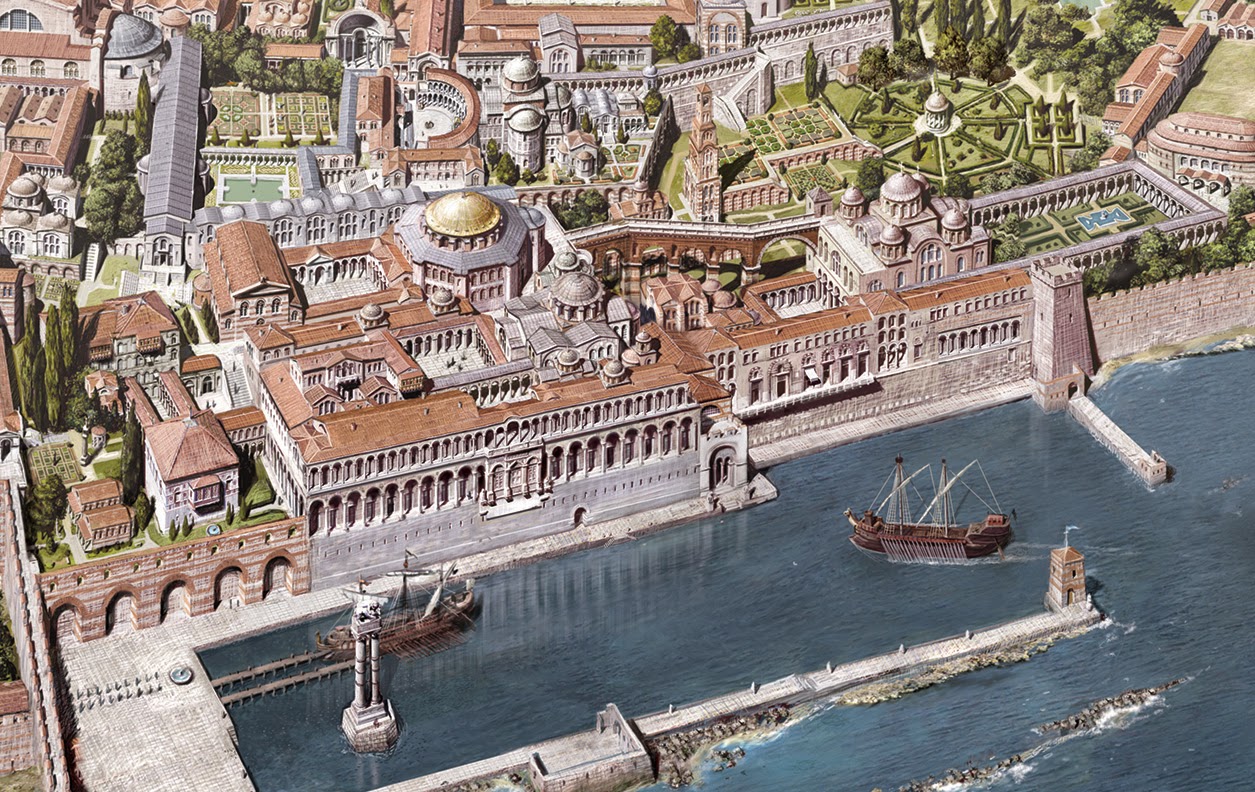

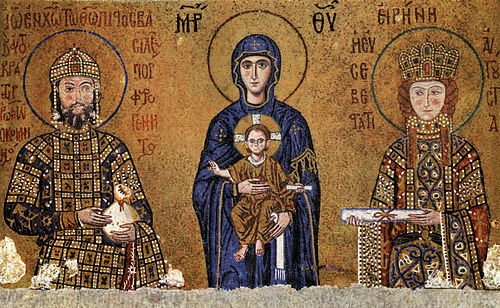
































































































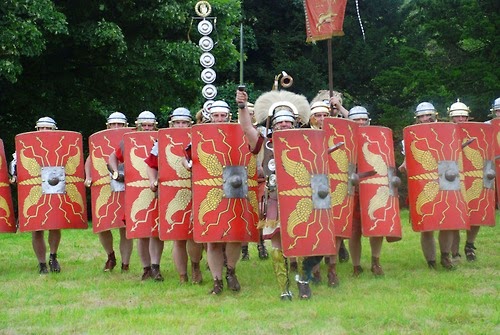















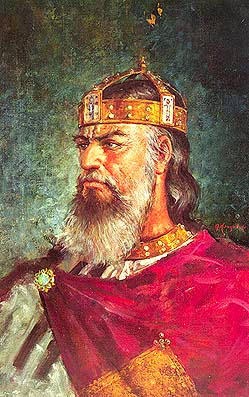


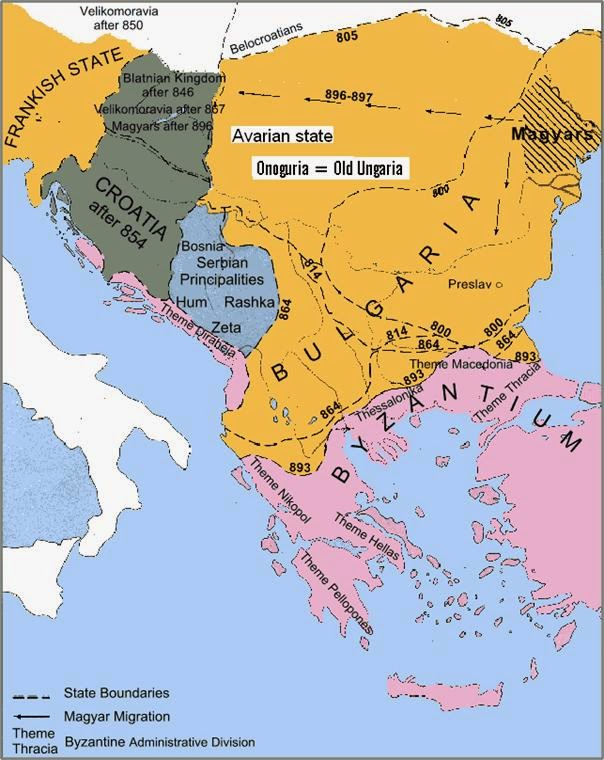







































.jpg)




